Grassland Carbon Change in Northern China under Historical and Future Land Use and Land Cover Change
Abstract
:1. Introduction
2. Materials and Methods
2.1. Study Area
2.2. Model Description
2.2.1. Land Use and Carbon Scenario Simulator (LUCAS)
2.2.2. CENTURY Model
2.2.3. Model Integration
2.3. Input Data
2.3.1. CENTURY Simulation Inputs
2.3.2. LULC Change Dataset
2.4. Simulation Scenarios
2.5. Model Initialization
3. Results
3.1. LULC Change during 1990–2050
3.2. LULC Change-Induced Carbon Loss in the Whole Region
3.3. LULC Change-Induced Grassland Carbon Loss
3.4. Grassland Net Biome Productivity Dynamics
4. Discussion
4.1. Impact of LULC Change on Grassland Carbon Change
4.2. Model Limitations and Further Work
5. Conclusions
Supplementary Materials
Author Contributions
Funding
Data Availability Statement
Acknowledgments
Conflicts of Interest
References
- Hong, C.; Burney, J.A.; Pongratz, J.; Nabel, J.E.M.S.; Mueller, N.D.; Jackson, R.B.; Davis, S.J. Global and regional drivers of land-use emissions in 1961–2017. Nature 2021, 589, 554–561. [Google Scholar] [CrossRef] [PubMed]
- Yang, Y.; Shi, Y.; Sun, W.; Chang, J.; Zhu, J.; Chen, L.; Wang, X.; Guo, Y.; Zhang, H.; Yu, L.; et al. Terrestrial carbon sinks in China and around the world and their contribution to carbon neutrality. Sci. China Life Sci. 2022, 65, 861–895. [Google Scholar] [CrossRef] [PubMed]
- Tian, H.; Melillo, J.; Lu, C.; Kicklighter, D.; Liu, M.; Ren, W.; Xu, X.; Chen, G.; Zhang, C.; Pan, S.; et al. China’s terrestrial carbon balance: Contributions from multiple global change factors. Glob. Biogeochem. Cycles 2011, 25, GB1007. [Google Scholar] [CrossRef]
- Fang, J.; Yang, Y.; Ma, W.; Mohammat, A.; Shen, H. Ecosystem carbon stocks and their changes in China’s grasslands. Sci. China Life Sci. 2010, 53, 757–765. [Google Scholar] [CrossRef]
- Friedlingstein, P.; Houghton, R.A.; Marland, G.; Hackler, J.; Boden, T.A.; Conway, T.J.; Canadell, J.G.; Raupach, M.R.; Ciais, P.; Le Quéré, C. Update on CO2 emissions. Nat. Geosci. 2010, 3, 811–812. [Google Scholar] [CrossRef]
- Scott, C.E.; Monks, S.A.; Spracklen, D.V.; Arnold, S.R.; Forster, P.M.; Rap, A.; Äijälä, M.; Artaxo, P.; Carslaw, K.S.; Chipperfield, M.P.; et al. Impact on short-lived climate forcers increases projected warming due to deforestation. Nat. Commun. 2018, 9, 157. [Google Scholar] [CrossRef]
- Stephens, L.; Fuller, D.; Boivin, N.; Rick, T.; Gauthier, N.; Kay, A.; Marwick, B.; Armstrong, C.G.; Barton, C.M.; Denham, T.; et al. Archaeological assessment reveals Earth’s early transformation through land use. Science 2019, 365, 897–902. [Google Scholar] [CrossRef]
- Friedlingstein, P.; O’Sullivan, M.; Jones, M.W.; Andrew, R.M.; Gregor, L.; Hauck, J.; Le Quéré, C.; Luijkx, I.T.; Olsen, A.; Peters, G.P.; et al. Global Carbon Budget 2022. Earth Syst. Sci. Data 2022, 14, 4811–4900. [Google Scholar] [CrossRef]
- Gasser, T.; Crepin, L.; Quilcaille, Y.; Houghton, R.A.; Ciais, P.; Obersteiner, M. Historical CO2 emissions from land use and land cover change and their uncertainty. Biogeosciences 2020, 17, 4075–4101. [Google Scholar] [CrossRef]
- Hartung, K.; Bastos, A.; Chini, L.; Ganzenmüller, R.; Havermann, F.; Hurtt, G.C.; Loughran, T.; Nabel, J.E.M.S.; Nützel, T.; Obermeier, W.A.; et al. Bookkeeping estimates of the net land-use change flux—A sensitivity study with the CMIP6 land-use dataset. Earth Syst. Dynam. 2021, 12, 763–782. [Google Scholar] [CrossRef]
- Yang, F.; He, F.; Li, S.; Li, M.; Wu, P. A new estimation of carbon emissions from land use and land cover change in China over the past 300 years. Sci. Total Environ. 2023, 863, 160963. [Google Scholar] [CrossRef]
- Hou, H.; Zhou, B.-B.; Pei, F.; Hu, G.; Su, Z.; Zeng, Y.; Zhang, H.; Gao, Y.; Luo, M.; Li, X. Future Land Use/Land Cover Change Has Nontrivial and Potentially Dominant Impact on Global Gross Primary Productivity. Earth’s Future 2022, 10, e2021EF002628. [Google Scholar] [CrossRef]
- Ding, L.; Li, Z.; Shen, B.; Wang, X.; Xu, D.; Yan, R.; Yan, Y.; Xin, X.; Xiao, J.; Li, M.; et al. Spatial patterns and driving factors of aboveground and belowground biomass over the eastern Eurasian steppe. Sci. Total Environ. 2022, 803, 149700. [Google Scholar] [CrossRef] [PubMed]
- Jiang, W.; Deng, Y.; Tang, Z.; Lei, X.; Chen, Z. Modelling the potential impacts of urban ecosystem changes on carbon storage under different scenarios by linking the CLUE-S and the InVEST models. Ecol. Model. 2017, 345, 30–40. [Google Scholar] [CrossRef]
- Zhu, L.; Song, R.; Sun, S.; Li, Y.; Hu, K. Land use/land cover change and its impact on ecosystem carbon storage in coastal areas of China from 1980 to 2050. Ecol. Indic. 2022, 142, 109178. [Google Scholar] [CrossRef]
- van Marle, M.J.E.; van Wees, D.; Houghton, R.A.; Field, R.D.; Verbesselt, J.; van der Werf, G.R. New land-use-change emissions indicate a declining CO2 airborne fraction. Nature 2022, 603, 450–454. [Google Scholar] [CrossRef] [PubMed]
- Yu, Z.; Lu, C.; Tian, H.; Canadell, J.G. Largely underestimated carbon emission from land use and land cover change in the conterminous United States. Glob. Chang. Biol. 2019, 25, 3741–3752. [Google Scholar] [CrossRef]
- Chang, X.; Xing, Y.; Wang, J.; Yang, H.; Gong, W. Effects of land use and cover change (LUCC) on terrestrial carbon stocks in China between 2000 and 2018. Resour. Conserv. Recycl. 2022, 182, 106333. [Google Scholar] [CrossRef]
- Tharammal, T.; Bala, G.; Narayanappa, D.; Nemani, R. Potential roles of CO2 fertilization, nitrogen deposition, climate change, and land use and land cover change on the global terrestrial carbon uptake in the twenty-first century. Clim. Dyn. 2019, 52, 4393–4406. [Google Scholar] [CrossRef]
- Ni, J. Carbon storage in grasslands of China. J. Arid. Environ. 2002, 50, 205–218. [Google Scholar] [CrossRef]
- Kang, L.; Han, X.; Zhang, Z.; Sun, O.J. Grassland ecosystems in China: Review of current knowledge and research advancement. Philos. Trans. R. Soc. B Biol. Sci. 2007, 362, 997–1008. [Google Scholar] [CrossRef]
- Liu, M.; Tian, H. China’s land cover and land use change from 1700 to 2005: Estimations from high-resolution satellite data and historical archives. Glob. Biogeochem. Cycles 2010, 24, 129022811. [Google Scholar] [CrossRef]
- Orie, L.; Ma, R.; George, S.; Tian, S.; Arthur, W.; Wan, C.; Wang, Z.; Wu, J.; Zhang, X. Grasslands and Grassland Sciences in Northern China; The National Academies Press: Washington, DC, USA, 1992; p. 230. [Google Scholar]
- John, R.; Chen, J.; Lu, N.; Wilske, B. Land cover/land use change in semi-arid Inner Mongolia: 1992–2004. Environ. Res. Lett. 2009, 4, 045010. [Google Scholar] [CrossRef]
- Yin, H.; Pflugmacher, D.; Li, A.; Li, Z.; Hostert, P. Land use and land cover change in Inner Mongolia—Understanding the effects of China’s re-vegetation programs. Remote Sens. Environ. 2018, 204, 918–930. [Google Scholar] [CrossRef]
- Lu, F.; Hu, H.; Sun, W.; Zhu, J.; Liu, G.; Zhou, W.; Zhang, Q.; Shi, P.; Liu, X.; Wu, X.; et al. Effects of national ecological restoration projects on carbon sequestration in China from 2001 to 2010. Proc. Natl. Acad. Sci. USA 2018, 115, 4039–4044. [Google Scholar] [CrossRef] [PubMed]
- Xin, X.; Jin, D.; Ge, Y.; Wang, J.; Chen, J.; Qi, J.; Chu, H.; Shao, C.; Murray, P.J.; Zhao, R.; et al. Climate Change Dominated Long-Term Soil Carbon Losses of Inner Mongolian Grasslands. Glob. Biogeochem. Cycles 2020, 34, e2020GB006559. [Google Scholar] [CrossRef]
- Liu, J.-H.; Gao, J.-X.; Lv, S.-H.; Han, Y.-W.; Nie, Y.-H. Shifting farming–pastoral ecotone in China under climate and land use changes. J. Arid. Environ. 2011, 75, 298–308. [Google Scholar] [CrossRef]
- Sleeter, B.M.; Liu, J.; Daniel, C.; Frid, L.; Zhu, Z. An integrated approach to modeling changes in land use, land cover, and disturbance and their impact on ecosystem carbon dynamics: A case study in the Sierra Nevada Mountains of California. AIMS Environ. Sci. 2015, 2, 577–606. [Google Scholar] [CrossRef]
- Daniel, C.J.; Sleeter, B.M.; Frid, L.; Fortin, M.-J. Integrating continuous stocks and flows into state-and-transition simulation models of landscape change. Methods Ecol. Evol. 2018, 9, 1133–1143. [Google Scholar] [CrossRef]
- Sleeter, B.M.; Liu, J.; Daniel, C.; Rayfield, B.; Sherba, J.; Hawbaker, T.J.; Zhu, Z.; Selmants, P.C.; Loveland, T.R. Effects of contemporary land-use and land-cover change on the carbon balance of terrestrial ecosystems in the United States. Environ. Res. Lett. 2018, 13, 045006. [Google Scholar] [CrossRef]
- Daniel, C.J.; Frid, L.; Sleeter, B.M.; Fortin, M.-J. State-and-transition simulation models: A framework for forecasting landscape change. Methods Ecol. Evol. 2016, 7, 1413–1423. [Google Scholar] [CrossRef]
- Parton, W.J.; Schimel, D.S.; Cole, C.V.; Ojima, D.S. Analysis of Factors Controlling Soil Organic Matter Levels in Great Plains Grasslands. Soil Sci. Soc. Am. J. 1987, 51, 1173–1179. [Google Scholar] [CrossRef]
- Parton, W.J.; Stewart, J.W.B.; Cole, C.V. Dynamics of C, N, P and S in grassland soils: A model. Biogeochemistry 1988, 5, 109–131. [Google Scholar] [CrossRef]
- Parton, W.J.; Scurlock, J.M.O.; Ojima, D.S.; Gilmanov, T.G.; Scholes, R.J.; Schimel, D.S.; Kirchner, T.; Menaut, J.-C.; Seastedt, T.; Garcia Moya, E.; et al. Observations and modeling of biomass and soil organic matter dynamics for the grassland biome worldwide. Glob. Biogeochem. Cycles 1993, 7, 785–809. [Google Scholar] [CrossRef]
- Ťupek, B.; Launiainen, S.; Peltoniemi, M.; Sievänen, R.; Perttunen, J.; Kulmala, L.; Penttilä, T.; Lindroos, A.-J.; Hashimoto, S.; Lehtonen, A. Evaluating CENTURY and Yasso soil carbon models for CO2 emissions and organic carbon stocks of boreal forest soil with Bayesian multi-model inference. Eur. J. Soil Sci. 2019, 70, 847–858. [Google Scholar]
- Zhao, W.; Qi, J.; Sun, G.; Li, F. Spatial patterns of top soil carbon sensitivity to climate variables in northern Chinese grasslands. Acta Agric. Scand. Sect. B Soil Plant Sci. 2012, 62, 720–731. [Google Scholar] [CrossRef]
- Gupta, S.; Kumar, S. Simulating climate change impact on soil carbon sequestration in agro-ecosystem of mid-Himalayan landscape using CENTURY model. Environ. Earth Sci. 2017, 76, 394. [Google Scholar] [CrossRef]
- Shi, X.Z.; Yu, D.S.; Warner, E.D.; Pan, X.Z.; Petersen, G.W.; Gong, Z.G.; Weindorf, D.C. Soil Database of 1:1,000,000 Digital Soil Survey and Reference System of the Chinese Genetic Soil Classification System. Soil Surv. Horiz. 2004, 45, 129–136. [Google Scholar] [CrossRef]
- Liu, J.; Liu, M.; Deng, X.; Zhuang, D.; Zhang, Z.; Luo, D. The land use and land cover change database and its relative studies in China. J. Geogr. Sci. 2002, 12, 275–282. [Google Scholar]
- Liu, J.; Liu, M.; Tian, H.; Zhuang, D.; Zhang, Z.; Zhang, W.; Tang, X.; Deng, X. Spatial and temporal patterns of China’s cropland during 1990–2000: An analysis based on Landsat TM data. Remote Sens. Environ. 2005, 98, 442–456. [Google Scholar] [CrossRef]
- Thomson, A.M.; Calvin, K.V.; Smith, S.J.; Kyle, G.P.; Volke, A.; Patel, P.; Delgado-Arias, S.; Bond-Lamberty, B.; Wise, M.A.; Clarke, L.E.; et al. RCP4.5: A pathway for stabilization of radiative forcing by 2100. Clim. Chang. 2011, 109, 77. [Google Scholar] [CrossRef]
- Jason, T.S.; Benjamin, M.S.; Adam, W.D.; Owen, P. Downscaling global land-use/land-cover projections for use in region-level state-and-transition simulation modeling. AIMS Environ. Sci. 2015, 2, 623–647. [Google Scholar]
- Schulze, E.-D.; Wirth, C.; Heimann, M. Managing Forests After Kyoto. Science 2000, 289, 2058–2059. [Google Scholar] [CrossRef]
- Deng, L.; Shangguan, Z.-P.; Li, R. Effects of the grain-for-green program on soil erosion in China. Int. J. Sediment Res. 2012, 27, 120–127. [Google Scholar] [CrossRef]
- Cao, S.; Chen, L.; Liu, Z. An Investigation of Chinese Attitudes toward the Environment: Case Study Using the Grain for Green Project. AMBIO A J. Hum. Environ. 2009, 38, 55–64. [Google Scholar] [CrossRef]
- Guo, L.B.; Gifford, R.M. Soil carbon stocks and land use change: A meta analysis. Glob. Change Biol. 2002, 8, 345–360. [Google Scholar] [CrossRef]
- Müller-Wenk, R.; Brandão, M. Climatic impact of land use in LCA—Carbon transfers between vegetation/soil and air. Int. J. Life Cycle Assess. 2010, 15, 172–182. [Google Scholar] [CrossRef]
- Song, J.; Wan, S.; Peng, S.; Piao, S.; Ciais, P.; Han, X.; Zeng, D.-H.; Cao, G.; Wang, Q.; Bai, W.; et al. The carbon sequestration potential of China’s grasslands. Ecosphere 2018, 9, e02452. [Google Scholar] [CrossRef]
- Deng, L.; Liu, G.-b.; Shangguan, Z.-p. Land-use conversion and changing soil carbon stocks in China’s ‘Grain-for-Green’ Program: A synthesis. Glob. Chang. Biol. 2014, 20, 3544–3556. [Google Scholar] [CrossRef] [PubMed]
- He, Z.; Lei, L.; Zeng, Z.-C.; Sheng, M.; Welp, L.R. Evidence of Carbon Uptake Associated with Vegetation Greening Trends in Eastern China. Remote Sens. 2020, 12, 718. [Google Scholar] [CrossRef]
- He, S.; Liang, Z.; Han, R.; Wang, Y.; Liu, G. Soil carbon dynamics during grass restoration on abandoned sloping cropland in the hilly area of the Loess Plateau, China. CATENA 2016, 137, 679–685. [Google Scholar]
- Xu, L.; Yu, G.; He, N. Increased soil organic carbon storage in Chinese terrestrial ecosystems from the 1980s to the 2010s. J. Geogr. Sci. 2019, 29, 49–66. [Google Scholar] [CrossRef]
- Li, Y.; Liu, W.; Feng, Q.; Zhu, M.; Yang, L.; Zhang, J. Effects of land use and land cover change on soil organic carbon storage in the Hexi regions, Northwest China. J. Environ. Manag. 2022, 312, 114911. [Google Scholar] [CrossRef] [PubMed]
- Lai, L.; Huang, X.; Yang, H.; Chuai, X.; Zhang, M.; Zhong, T.; Chen, Z.; Chen, Y.; Wang, X.; Thompson, J.R. Carbon emissions from land-use change and management in China between 1990 and 2010. Sci. Adv. 2016, 2, e1601063. [Google Scholar] [CrossRef] [PubMed]
- Diao, J.; Liu, J.; Zhu, Z.; Li, M.; Sleeter, B.M. Substantially Greater Carbon Emissions Estimated Based on Annual Land-Use Transition Data. Remote Sens. 2020, 12, 1126. [Google Scholar] [CrossRef]
- Liu, X.; Liang, X.; Li, X.; Xu, X.; Ou, J.; Chen, Y.; Li, S.; Wang, S.; Pei, F. A future land use simulation model (FLUS) for simulating multiple land use scenarios by coupling human and natural effects. Landsc. Urban Plan. 2017, 168, 94–116. [Google Scholar] [CrossRef]
- Li, X.; Chen, G.; Liu, X.; Liang, X.; Wang, S.; Chen, Y.; Pei, F.; Xu, X. A New Global Land-Use and Land-Cover Change Product at a 1-km Resolution for 2010 to 2100 Based on Human–Environment Interactions. Ann. Am. Assoc. Geogr. 2017, 107, 1040–1059. [Google Scholar] [CrossRef]
- Xu, H.-j.; Wang, X.-p.; Zhang, X.-x. Decreased vegetation growth in response to summer drought in Central Asia from 2000 to 2012. Int. J. Appl. Earth Obs. Geoinf. 2016, 52, 390–402. [Google Scholar] [CrossRef]
- Song, X.; Yang, G.; Yan, C.; Duan, H.; Liu, G.; Zhu, Y. Driving forces behind land use and cover change in the Qinghai-Tibetan Plateau: A case study of the source region of the Yellow River, Qinghai Province, China. Environ. Earth Sci. 2009, 59, 793–801. [Google Scholar] [CrossRef]
- Peng, W.; Ma, N.L.; Zhang, D.; Zhou, Q.; Yue, X.; Khoo, S.C.; Yang, H.; Guan, R.; Chen, H.; Zhang, X.; et al. A review of historical and recent locust outbreaks: Links to global warming, food security and mitigation strategies. Environ. Res. 2020, 191, 110046. [Google Scholar] [CrossRef]
- Yang, J.; Wang, S.; Su, W.; Yu, Q.; Wang, X.; Han, Q.; Zheng, Y.; Qu, J.; Li, X.; Li, H. Animal Activities of the Key Herbivore Plateau Pika (Ochotona curzoniae) on the Qinghai-Tibetan Plateau Affect Grassland Microbial Networks and Ecosystem Functions. Front. Microbiol. 2022, 13, 950811. [Google Scholar] [CrossRef] [PubMed]
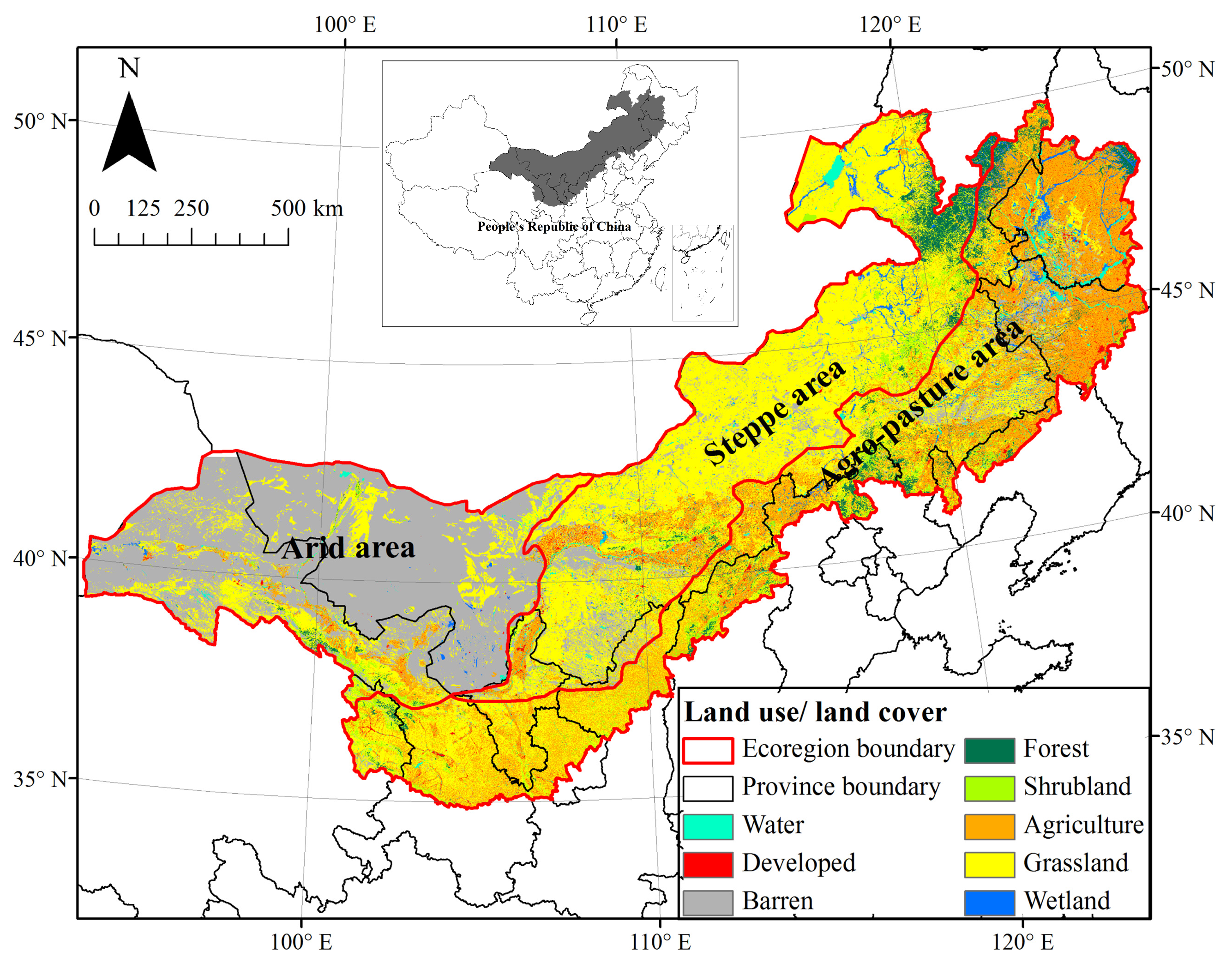
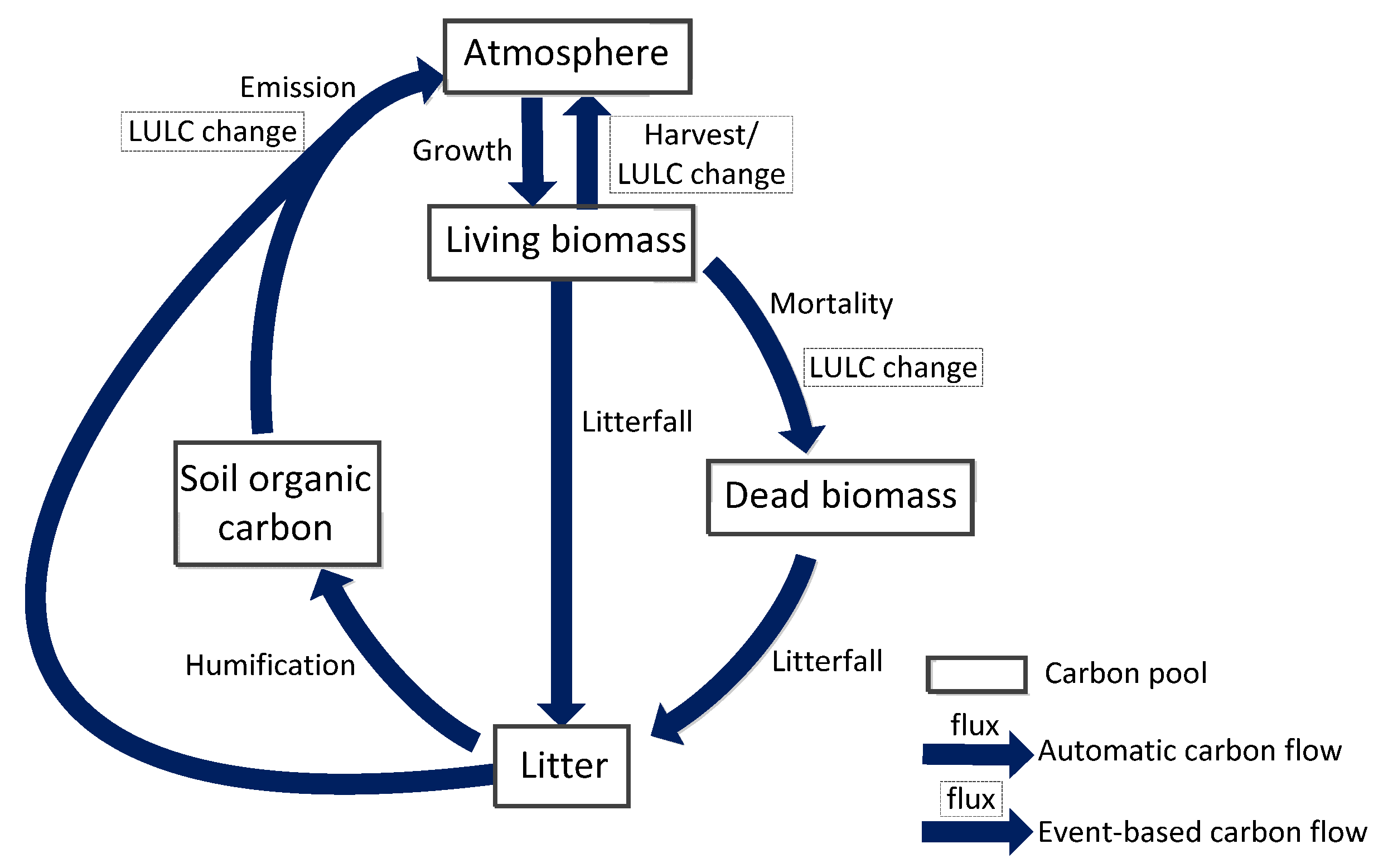
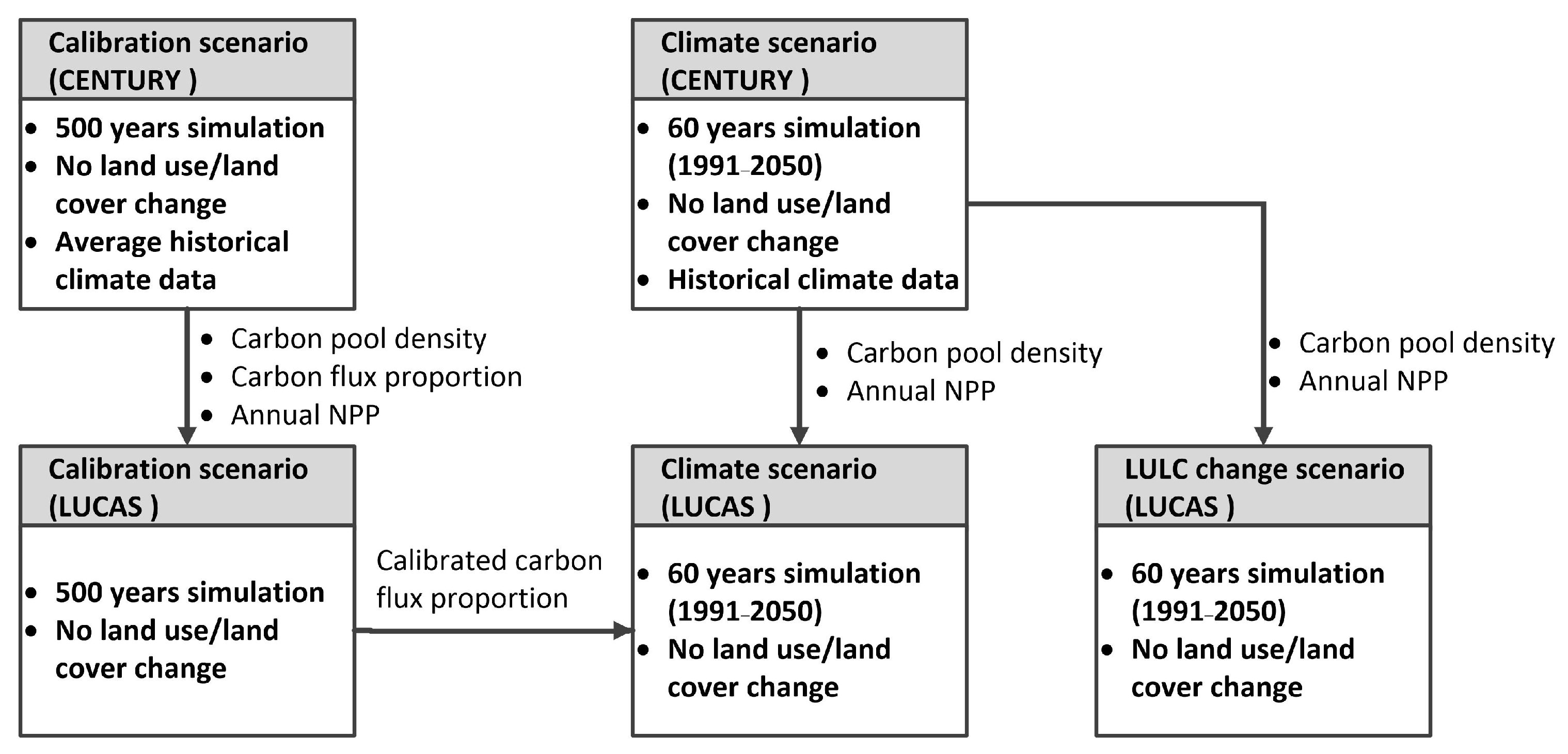
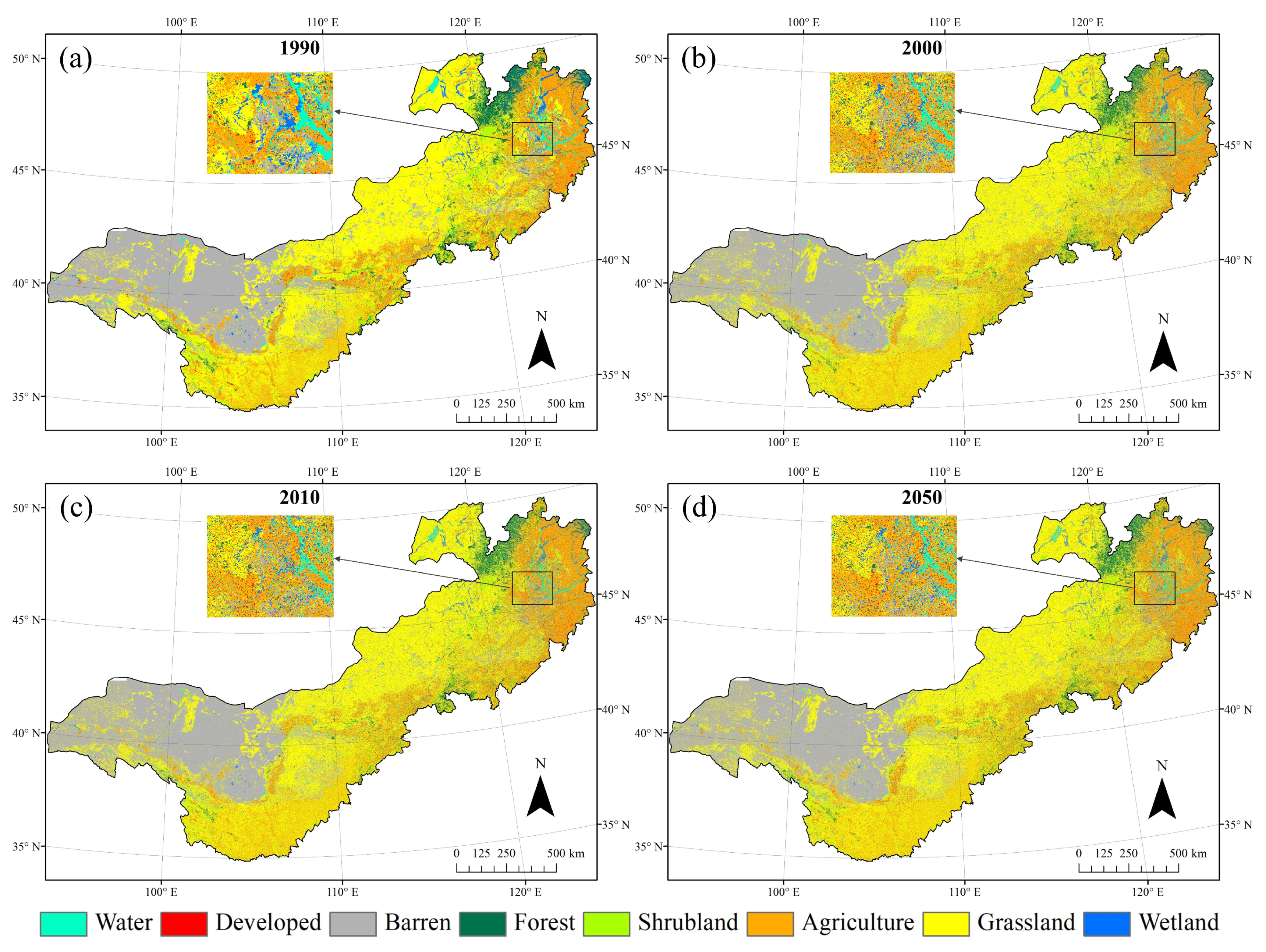
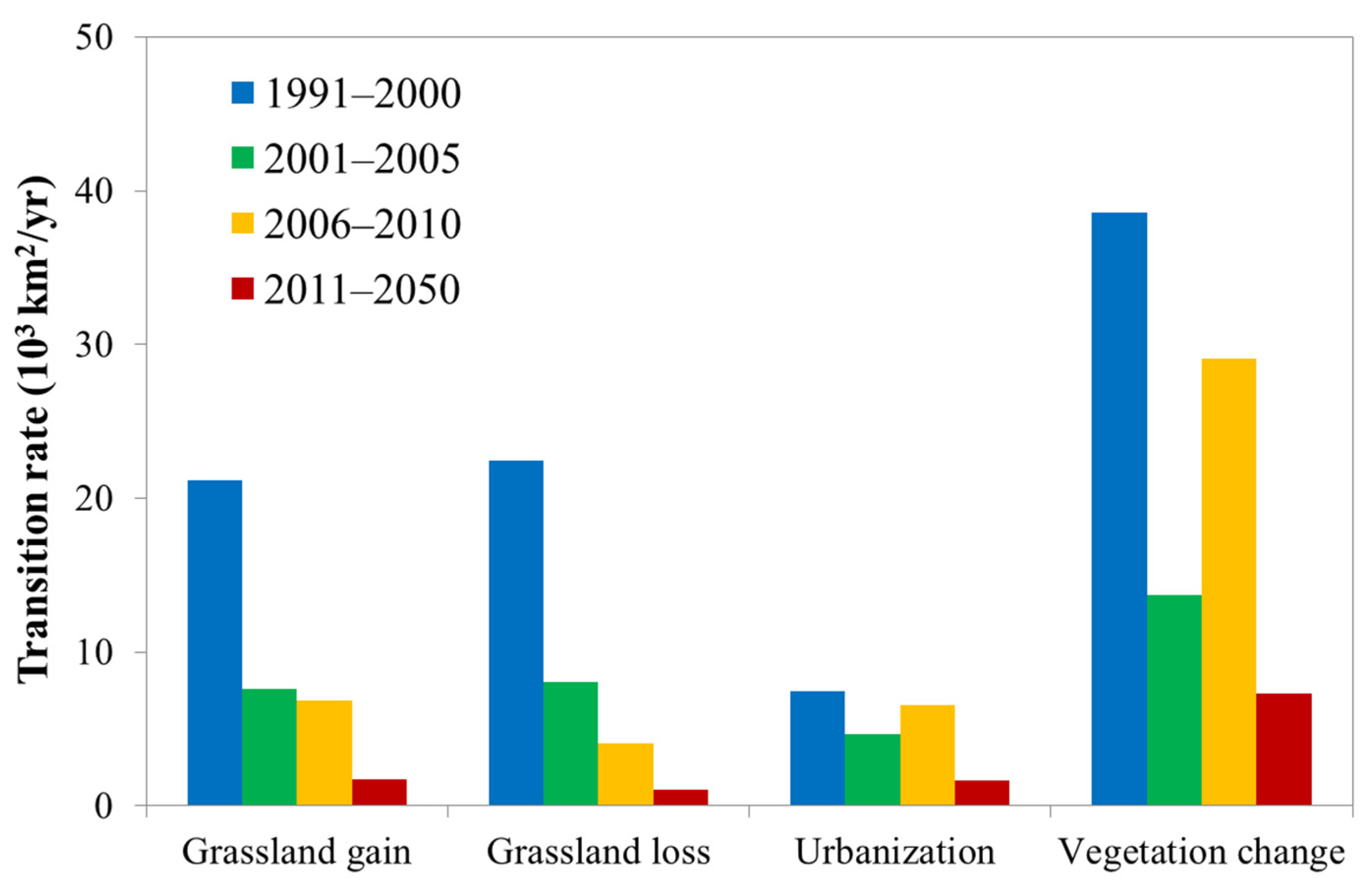
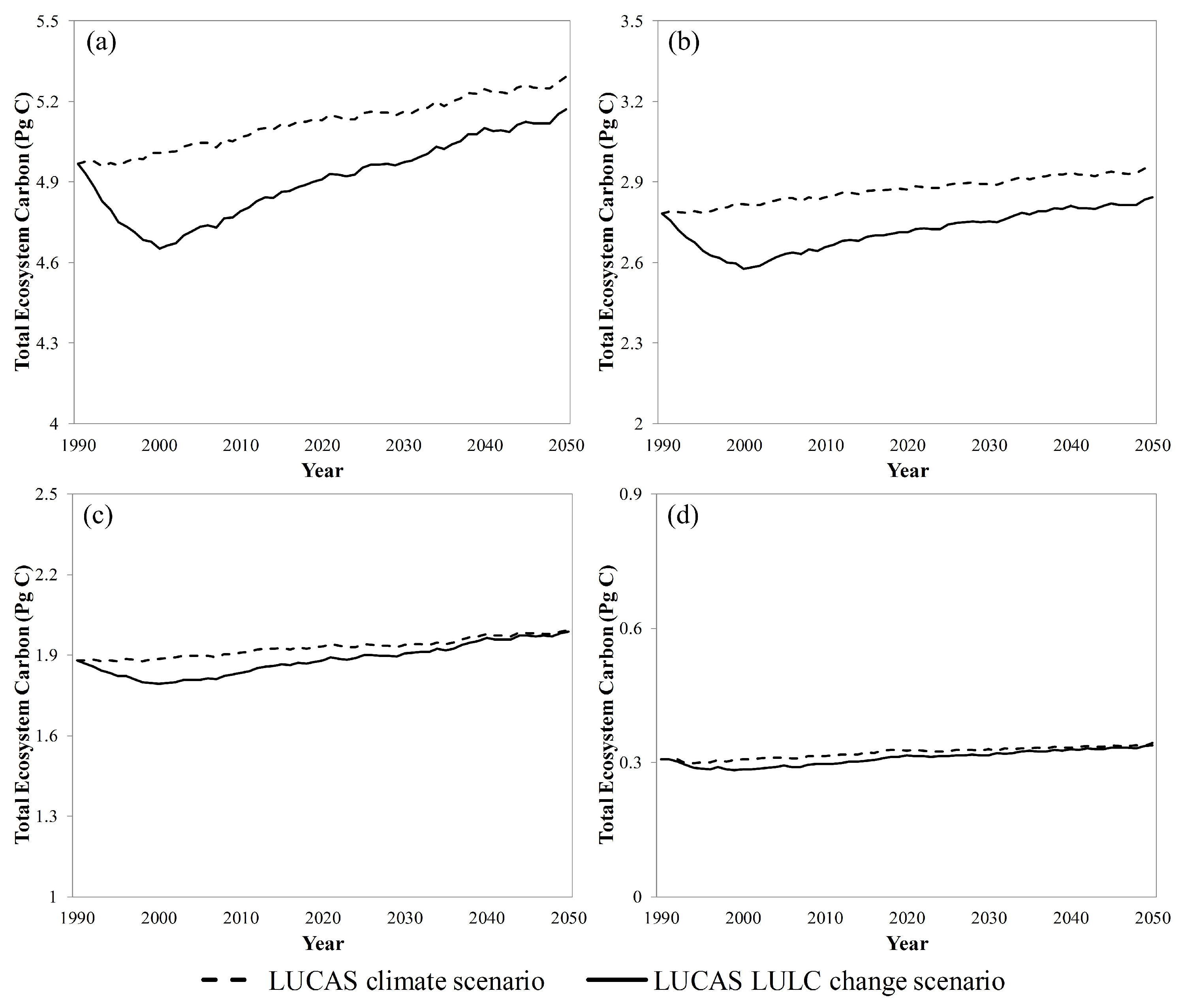

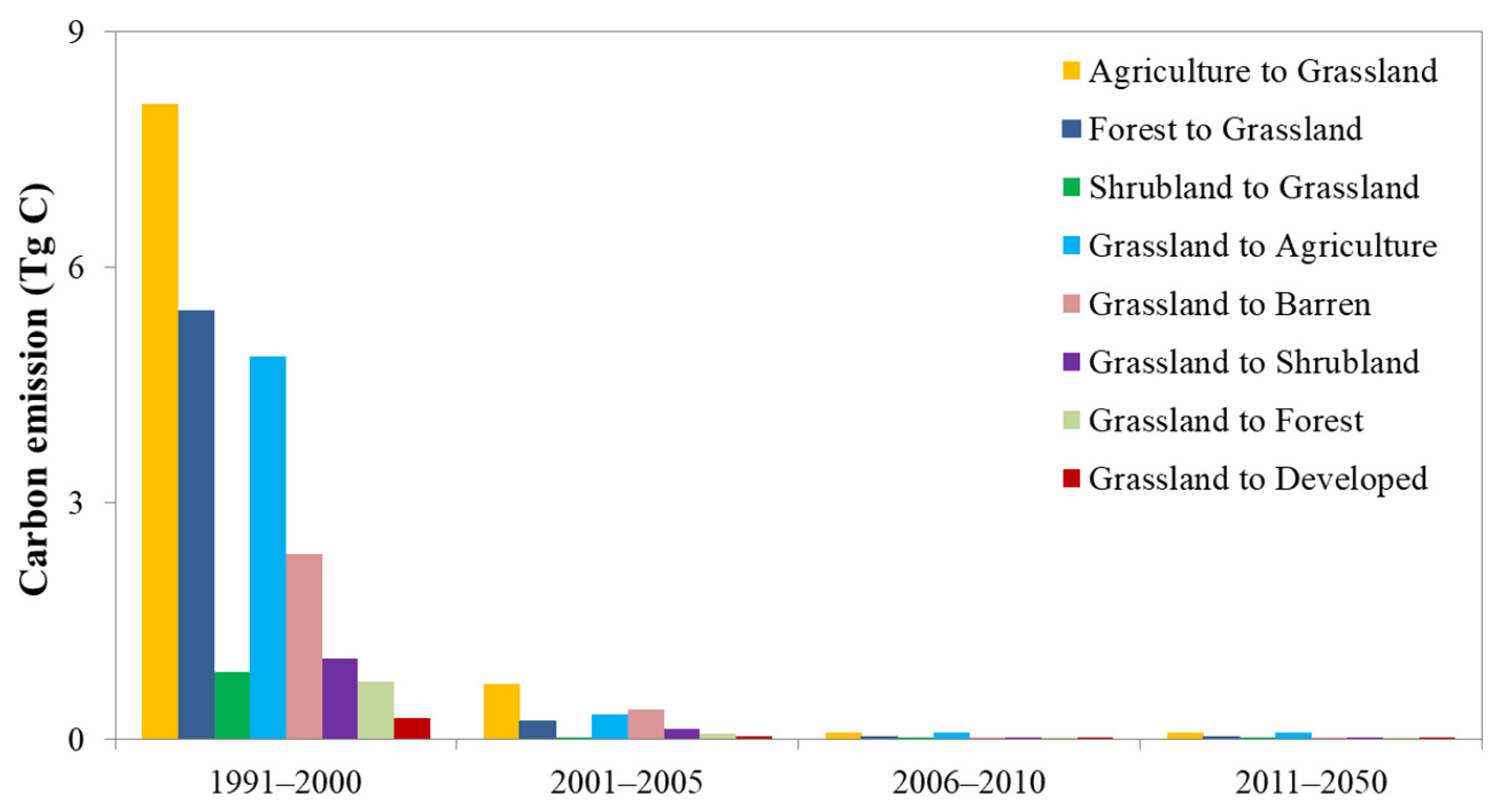
| LULC Class | 1990 | 2000 | 2005 | 2010 | 2020 | 2050 |
|---|---|---|---|---|---|---|
| Grassland | 706.84 | 693.43 | 690.74 | 691.56 | 692.89 | 697.44 |
| Agriculture | 331.06 | 348.86 | 347.97 | 348.00 | 348.08 | 348.40 |
| Barren | 462.84 | 464.46 | 466.57 | 464.92 | 461.85 | 452.31 |
| Developed | 24.69 | 25.42 | 26.22 | 26.70 | 27.60 | 30.17 |
| Forest | 65.12 | 65.59 | 66.05 | 66.03 | 66.01 | 65.88 |
| Shrubland | 63.10 | 59.66 | 61.40 | 61.75 | 62.43 | 64.33 |
| Water | 30.50 | 29.58 | 28.42 | 28.62 | 29.03 | 30.30 |
| Wetland | 34.69 | 31.89 | 31.51 | 31.36 | 31.09 | 30.19 |
| LULC Transition Type | 1991–2000 | 2001–2005 | 2006–2010 | 2011–2050 |
|---|---|---|---|---|
| Grassland gain | 14.52 | 1.27 | 0.10 | 0.12 |
| Grassland loss | 9.91 | 1.22 | 0.86 | 0.34 |
| Urbanization | 2.26 | 0.38 | 0.11 | 0.11 |
| Vegetation change | 13.44 | 0.97 | 0.24 | 0.36 |
| Annual NBP (Tg C/yr) | LUCAS_CLIM Scenario | LUCAS_LULCC Scenario | ||||
|---|---|---|---|---|---|---|
| 1991–2000 | 2001–2010 | 2011–2050 | 1991–2000 | 2001–2010 | 2011–2050 | |
| Whole region | −2.69 | −0.75 | 1.45 | −15.54 | 0.41 | 2.44 |
| Agro-pasture area | −0.88 | −0.95 | 0.65 | −8.63 | 0.006 | 1.12 |
| Steppe area | −2.70 | −0.26 | 0.32 | −7.32 | −0.36 | 0.52 |
| Arid area | 0.89 | 0.46 | 0.48 | 0.41 | 0.76 | 0.80 |
Disclaimer/Publisher’s Note: The statements, opinions and data contained in all publications are solely those of the individual author(s) and contributor(s) and not of MDPI and/or the editor(s). MDPI and/or the editor(s) disclaim responsibility for any injury to people or property resulting from any ideas, methods, instructions or products referred to in the content. |
© 2023 by the authors. Licensee MDPI, Basel, Switzerland. This article is an open access article distributed under the terms and conditions of the Creative Commons Attribution (CC BY) license (https://creativecommons.org/licenses/by/4.0/).
Share and Cite
Li, Z.; Tang, Q.; Wang, X.; Chen, B.; Sun, C.; Xin, X. Grassland Carbon Change in Northern China under Historical and Future Land Use and Land Cover Change. Agronomy 2023, 13, 2180. https://doi.org/10.3390/agronomy13082180
Li Z, Tang Q, Wang X, Chen B, Sun C, Xin X. Grassland Carbon Change in Northern China under Historical and Future Land Use and Land Cover Change. Agronomy. 2023; 13(8):2180. https://doi.org/10.3390/agronomy13082180
Chicago/Turabian StyleLi, Zhenwang, Quan Tang, Xu Wang, Baorui Chen, Chengming Sun, and Xiaoping Xin. 2023. "Grassland Carbon Change in Northern China under Historical and Future Land Use and Land Cover Change" Agronomy 13, no. 8: 2180. https://doi.org/10.3390/agronomy13082180
APA StyleLi, Z., Tang, Q., Wang, X., Chen, B., Sun, C., & Xin, X. (2023). Grassland Carbon Change in Northern China under Historical and Future Land Use and Land Cover Change. Agronomy, 13(8), 2180. https://doi.org/10.3390/agronomy13082180








